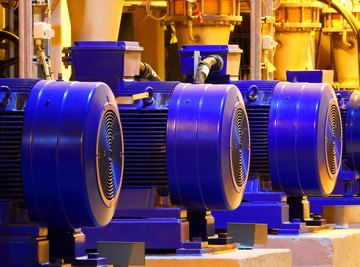
"Inrush current," sometimes called locked-rotor current or starting current, refers to the electrical current flowing through the components of a motor in the fractions of a second after the motor's power turns on. In this brief time interval, current rapidly waxes and wanes before any of the parts of the motor actually begin to move and the system progresses toward a dynamic electrical equilibrium, at which time a steady-state current is achieved.
The repeated short spikes of current with amperage values many times that of the steady state represent a potential disruption to the system, as they can result in the unnecessary tripping of fault devices in a "false alarm" manner.
Characteristics of the motor, such as DC current, a change in power supply and lighting ballasts can all increase the magnitude of the inrush current. You may need to know the value of this current so you can equip your motor with the right inrush current limiter to protect it against the tripping noted above, rather like a surge protector in a household power strip.
You will usually need to know the motor's maximum output power and the input voltage. Other helpful pieces of information include reset time, whether the circuit is single-phase or three-phase, the magnitude of the capacitance, the resistance and the motor efficiency.
For these kinds of problems, you will usually make use of the relationships:
Vpeak = IinR, where Vpeak = √2(V)
and
E = CV2/2
For example, assume you have a motor with an input voltage of 200 V and a minimum resistance of 15 Ω.
Step 1: Assemble the Variables
In this problem, you do not have energy or capacitance, but you do have voltage and resistance. Thus the equation of interest is the first one above, or:
√2(200) = Iin(15)
Step 2: Calculate the Inrush Current
This yields:
282.8/15 = Iin = 18.85 A
Step 3: Interpret the Findings
This means that any elements of the motor that are triggered to stop at amperage values this high may cause problems at start-up and that you may need to alter parameters such as voltage and resistance.
References
Tips
- The inrush current is only momentary and if the circuit breaker is sized properly, it will not trip in the fraction of second the current spikes. As the motor windings become energized, they present resistance to the flow of current and the current begins to drop. As the motor comes up to full speed, the current level will be at the level specified on the motor nameplate as the full-load current.
Warnings
- The voltage is important to determining inrush current. If the motor nameplate lists multiple voltages, the voltage being used must be determined. An easy place to measure this is at the motor disconnect. The type of voltage determines how the measurement is made. Measure three-phase current between two hot terminals and double it. Split phase current is measured between two hot terminals. Single phase current is measured from the hot terminal to ground.
About the Author
Kevin Beck holds a bachelor's degree in physics with minors in math and chemistry from the University of Vermont. Formerly with ScienceBlogs.com and the editor of "Run Strong," he has written for Runner's World, Men's Fitness, Competitor, and a variety of other publications. More about Kevin and links to his professional work can be found at www.kemibe.com.
